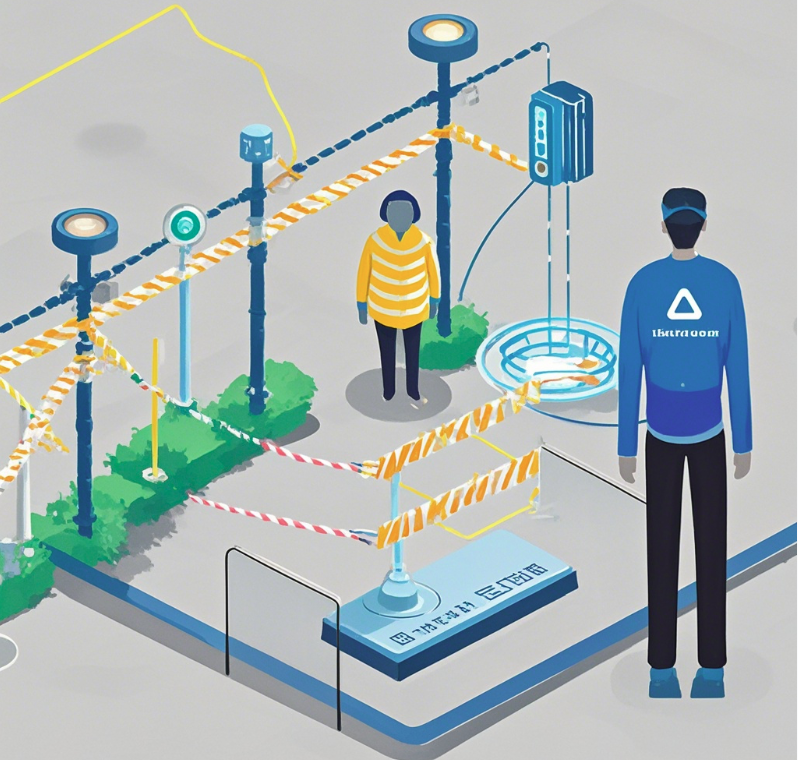In the blasting area, the use of UWB ultra wideband, Bluetooth and other personnel positioning technologies combined with virtual (boundary setting based on positioning technology) and physical (physical protection with sensors) electronic fence technology can achieve real-time monitoring, permission management, abnormal warning and historical data recording analysis of personnel, ensuring the safety of blasting operations. It is necessary to deploy base stations and tags reasonably and set and maintain electronic fence parameters.

1、 System Overview
Setting up personnel positioning and electronic fence systems in the blasting area is a key measure to ensure the safety of blasting operations. By combining high-precision personnel positioning technology with electronic fence function, real-time monitoring of personnel entering the blasting area can be achieved, effectively preventing unrelated personnel from entering, and restricting and managing the activity range of legally entered personnel, ensuring that blasting operations are carried out in a safe and controllable environment.
2、 Personnel positioning technology
UWB Ultra Wideband Positioning Technology
Principle: Determine the location of the positioning tag carried by personnel based on parameters such as transmission time, time difference, or angle of the ultra wideband pulse signal. For example, by measuring the time difference between UWB signals sent from a tag to multiple base stations (TDOA method), the three-dimensional coordinates of the tag can be accurately calculated with centimeter level accuracy.
Advantages: In complex blasting environments, UWB technology has strong anti-interference ability and can penetrate certain obstacles such as walls, equipment, etc., accurately obtaining personnel positions. And its positioning accuracy is high, suitable for fine monitoring of personnel activities in dangerous areas.
Bluetooth positioning technology (optional)
Principle: Use the strength of Bluetooth signal (RSSI) to estimate the distance between personnel and Bluetooth beacons, and then achieve positioning through multiple beacons. Alternatively, Bluetooth AoA (Angle of Arrival) technology can be used to improve positioning accuracy by measuring the angle of Bluetooth signals.
Applicable scenarios: Suitable for auxiliary positioning methods that do not require extremely high accuracy, but require large-area coverage and low cost. For example, in some buffer zones around the blasting area, Bluetooth positioning can be used to preliminarily monitor the approximate location of personnel.
3、 Electronic fence technology
Virtual electronic fence
Based on positioning technology implementation: By setting the boundary coordinates of the blasting area in the system, when the positioning tag carried by personnel crosses these preset boundaries, the system will trigger an alarm. For example, by combining UWB positioning system with geographic information system (GIS), the electronic fence range of the blasting area is delineated on the GIS map. Once personnel break through, the system immediately responds.
Alarm and linkage mechanism: When someone illegally enters or leaves the designated area, the system will emit sound and light alarm signals, and can also be linked with other security devices (such as access control systems, video surveillance systems, etc.). For example, notifying the access control system to close relevant channels to prevent more people from entering the dangerous area, and activating the video surveillance system to focus on tracking and filming those who enter the area.
Physical electronic fence (auxiliary)
Physical protective facilities: Set up some physical obstacles around the blasting area, such as fences, protective nets, etc., and install sensors on these physical facilities. When personnel touch these physical fences, the sensors will transmit signals to the control system, triggering an alarm. This method can serve as a supplement to virtual electronic fences, enhancing the reliability of protection.
4、 System functions and advantages
Real time monitoring and warning
The system can display the location, quantity, and movement trajectory of personnel in the blasting area in real time. Once abnormal situations are detected (such as personnel approaching dangerous blasting points, unauthorized intrusion, etc.), an immediate warning will be issued, allowing safety management personnel to take timely measures.
Personnel management and permission settings
Personnel entering the blasting area can be classified and managed, with different activity permissions and area ranges set for different types of personnel (such as blasting operators, safety inspectors, etc.). Only authorized personnel's activities within the specified time and scope are allowed, which improves the efficiency and security of personnel management.
Historical data recording and analysis
Record and store activity data of personnel in the blasting area, and evaluate the safety of blasting operations and the standardization of personnel operations through data analysis, providing a basis for subsequent safety improvement measures. For example, analyzing whether the actions of personnel during the preparation and evacuation stages of blasting comply with standard procedures and identify potential safety hazards.
5、 System deployment and maintenance
Base station and tag deployment
Reasonably deploy personnel to locate base stations based on the size, shape, and complexity of the blasting area. Before personnel enter the blasting area, equip them with corresponding positioning tags and ensure good signal between the tags and the base station. At the same time, it is necessary to regularly check the working status of base stations and tags to ensure the normal operation of the system.
Electronic fence parameter settings and updates
Adjust the parameters of the electronic fence in a timely manner according to the different stages and actual situation of the blasting operation, such as boundary range, warning distance, etc. After the blasting operation is completed, conduct a comprehensive inspection and maintenance of the system to prepare for the next operation.
Prev:The Excellent Application and Value of UWB Modules in the Field of Human Vehicle Positioning Safety
Next:UWB ranging module: principle, composition, characteristics, applications, and common products
Copyrights© Shenzhen Skylab Co.,LTD All Rights Reserved.

